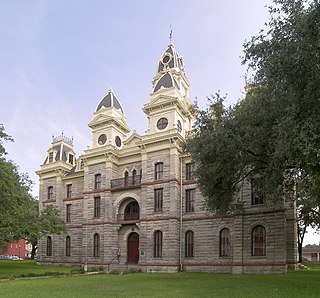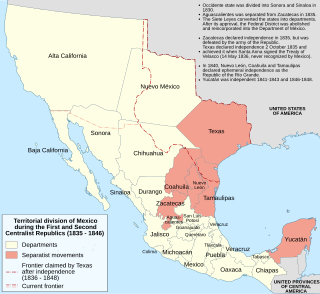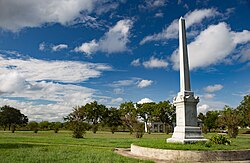
Goliad County is a county located in the U.S. state of Texas. As of the 2010 census, the population is 7,210. Its county seat is Goliad. The county is named for Father Miguel Hidalgo; "Goliad" is an anagram, minus the silent H. The county was created in 1836 and organized the next year.

Goliad is a city in Goliad County, Texas, United States. It is known for the 1836 Goliad massacre during the Texas Revolution. It had a population of 1,620 at the 2020 census. Founded on the San Antonio River, it is the county seat of Goliad County. It is part of the Victoria, Texas, Metropolitan Statistical Area.

The Battle of San Jacinto, fought on April 21, 1836, in present-day La Porte and Pasadena, Texas, was the final and decisive battle of the Texas Revolution. Led by General Samuel Houston, the Texan Army engaged and defeated General Antonio López de Santa Anna's Mexican army in a fight that lasted just 18 minutes. A detailed, first-hand account of the battle was written by General Houston from the headquarters of the Texan Army in San Jacinto on April 25, 1836. Numerous secondary analyses and interpretations have followed.

The Goliad massacre was an event of the Texas Revolution that occurred on March 27, 1836, following the Battle of Refugio and the Battle of Coleto; 425–445 prisoners of war from the Texian Army of the Republic of Texas were executed by the Mexican Army in the town of Goliad, Texas. Among those killed were their commanders Colonel James Fannin and Lieutenant Colonel William Ward. The killing was carried out under orders from General and President of Mexico Antonio Lopez de Santa Anna. Despite the appeals for clemency by General José de Urrea, the massacre was carried out by Lt. Colonel José Nicolás de la Portilla.

The Goliad Campaign was the 1836 Mexican offensive to retake the Texas Gulf Coast during the Texas Revolution. Mexican troops under the command of General José de Urrea defeated rebellious immigrants to the Mexican province of Texas, known as Texians, in a series of clashes in February and March.

The Battle of Coleto, also known as the Battle of Coleto Creek, the Battle of the Prairie, and the Batalla del Encinal del Perdido, was fought on March 19–20, 1836, during the Goliad campaign of the Texas Revolution. In February, General José de Urrea led a branch of the Mexican army up the Gulf Coast of Mexican Texas toward Goliad, where a large contingent of soldiers from the Texian Army was garrisoned under Colonel James W. Fannin. Simultaneously, Mexican president Antonio Lopez de Santa Anna led a larger force into the Texian interior, where on March 6 his troops won the Battle of the Alamo. After learning of the Alamo's defeat, Texian general Sam Houston ordered Fannin to retreat from Goliad and join the rest of the army in Victoria.

James Walker Fannin Jr. was an American military figure and slave trader in the Texas Army and leader during the Texas Revolution of 1835–36. After being outnumbered and surrendering to Mexican forces at the Battle of Coleto Creek, Colonel Fannin and nearly all his 344 men were executed soon afterward at Goliad, Texas, under Santa Anna's orders for all rebels to be executed.

The San Jacinto Monument is a 567.31-foot-high (172.92-meter) column located on the Houston Ship Channel in unincorporated Harris County, Texas, near the city of Houston. The monument is topped with a 220-ton star that commemorates the site of the Battle of San Jacinto, the decisive battle of the Texas Revolution. The monument, constructed between 1936 and 1939 and dedicated on April 21, 1939, is the world's tallest masonry column and is part of the San Jacinto Battleground State Historic Site. By comparison, the Washington Monument is 554.612 feet (169.046 m) tall, which is the tallest stone monument in the world. The column is an octagonal shaft topped with a 34-foot (10 m) Lone Star – the symbol of Texas. Visitors can take an elevator to the monument's observation deck for a view of Houston and the Battleship Texas.

The Battle of Refugio was fought from March 12–15, 1836, near Refugio, Texas. Mexican General José Urrea and 1,500 Centralista soldiers fought against Amon B. King and his 28 American volunteers and Lieutenant Colonel William Ward and his approximately 120 Americans. The battle, a part of the Goliad Campaign of the Texas Revolution, resulted in a Mexican victory and splintered Texan resistance.

The Runaway Scrape events took place mainly between September 1835 and April 1836 and were the evacuations by Texas residents fleeing the Mexican Army of Operations during the Texas Revolution, from the Battle of the Alamo through the decisive Battle of San Jacinto. The ad interim government of the new Republic of Texas and much of the civilian population fled eastward ahead of the Mexican forces. The conflict arose after Antonio López de Santa Anna abrogated the 1824 Constitution of Mexico and established martial law in Coahuila y Tejas. The Texians resisted and declared their independence. It was Sam Houston's responsibility, as the appointed commander-in-chief of the Provisional Army of Texas, to recruit and train a military force to defend the population against troops led by Santa Anna.
This is a timeline of the Republic of Texas, spanning the time from the Texas Declaration of Independence from Mexico on March 2, 1836, up to the transfer of power to the State of Texas on February 19, 1846.

Park Road 27 or PR 27 is a Texas park road that runs from Fannin to the Fannin Battleground State Historic Site, which is the site of the Battle of Coleto. PR 27 was originally SH 162 and briefly Spur 91 before gaining its current designation in 1940.

The San Jacinto Battleground State Historic Site includes the location of the Battle of San Jacinto and the museum ship USS Texas. It is located off the Houston Ship Channel in unincorporated Harris County, Texas near the city of Houston. The site was designated a National Historic Landmark in 1960.

The Presidio Nuestra Señora de Loreto de la Bahía, known more commonly as Presidio La Bahía, or simply La Bahía is a fort constructed by the Spanish Army that became the nucleus of the modern-day city of Goliad, Texas, United States. The current location dates to 1747.
Plácido Benavides (1810–1837) was an early Mexican-born settler in De Leon's Colony, Victoria County, Texas. Benavides earned himself the sobriquet of the Paul Revere of Texas for his 1836 journey from San Patricio to Goliad to Victoria, warning residents of the approaching Mexican army. He was twice elected alcalde of Victoria, Texas. He married into the powerful De León family, and with his wife Agustina became the father of three daughters. Benavides fought against the dictatorship of Antonio López de Santa Anna, but did not feel Texas should be separated from Mexico.

Mission Nuestra Señora del Espíritu Santo de Zúñiga, also known as Aranama Mission or Mission La Bahía, was a Roman Catholic mission established by Spain in 1722 in the Viceroyality of New Spain—to convert native Karankawa Indians to Christianity. Together with its nearby military fortress, Presidio La Bahía, the mission upheld Spanish territorial claims in the New World against encroachment from France. The third and final location near Goliad, Texas is maintained now as part of Goliad State Park and Historic Site.
Paul Revere of Texas is a sobriquet given to people during the Texas Revolution for alerting settlers about Mexican troop movements. It is a reference to Paul Revere because of the similar circumstances in 1775 when Revere and William Dawes responded to information from Joseph Warren about movement of British forces. The duo made rides alerting Samuel Adams, John Hancock and colonial militia troops.

The Zaragoza Birthplace State Historic Park is located adjacent to Presidio La Bahía in Goliad State Park and Historic Site, Goliad County in the U.S. state of Texas. An amphitheater and bronze statue of Ignacio Zaragoza are also on the grounds.

Goliad State Park and Historic Site is a 188.3 acres (76 ha) state park located along the San Antonio River on the southern edge of Goliad, Texas. It was listed on the National Register of Historic Places (#01000258) on March 12, 2001.



















